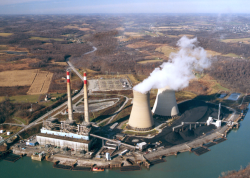
FirstEnergyThe Hatfield’s Ferry power plant in Greene County. Goodbye and good riddance.
The coal sector is in its death throes, thanks to cheaper alternatives and a growing distaste for what is the worst of the global-warming fuels. The latest casualties: two coal-burning power plants in Pennsylvania that will pump their last energy into the grid, and cough their last pollution in to the air, this weekend.
Officials with FirstEnergy Generation told state lawmakers on Thursday that their 370-megawatt plant in Washington County and its monster, 1,710-megawatt facility in Greene County will shutter next week, with little to no hope of them being sold or reopened.
“Those plants are losing money today and will lose money in the future. Our plans are not to run those units again,” said James Lash, FirstEnergy’s president, according to a report in the Pittsburgh Tribune-Review:
Lash painted a grim future for coal-fired power plants, saying electricity is priced too low in a market where demand for power has dropped and the capital investment needed to meet environmental regulations is too high. Electricity prices have dropped 10 percent from summer to fall, while the cost of natural gas — which also is used as a fuel for power generation — remains at historic low levels because of the abundance of gas from supplies such as the Marcellus shale reserves, Lash said.
It would take another $270 million investment to make the two plants compliant with environmental regulations, including the pending Mercury and Air Toxic Standards rule, which would result in the plants being greater money losers if the company were to make those investments, Lash said.
The previous owner of the plants, Allegheny Energy of Greensburg, spent $715 million in 2009 to install scrubbers at Hatfield’s Ferry.
While the plants’ closure is good news for the climate, it will mean a lot of pain for workers. An estimated 380 union jobs will be lost. Here’s hoping those workers can find better, more healthful jobs in the fast-growing renewable energy sector, which is being supported in Pennsylvania with nine-year-old renewable energy standards that include what the NRDC describes as one of the most ambitious solar provisions in the eastern United States.



